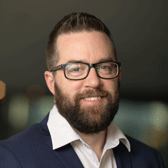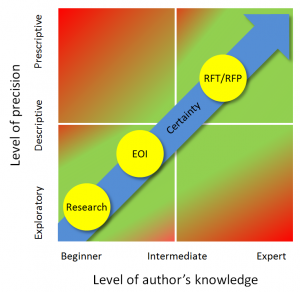 Writing project requirements well is not as easy as you think. How do we get it right to improve outcomes? Chris Needham, BIM advisory consultant for AECOM, takes a look
Writing project requirements well is not as easy as you think. How do we get it right to improve outcomes? Chris Needham, BIM advisory consultant for AECOM, takes a look
When we want to procure a new service or product, if we want good project outcomes we need to get a few basic things right. If we don’t, we run a high risk of regretting our purchase or not achieving the outcome we want. It’s not rocket science, but it’s very common to overlook what these are.
There’s a great quote that summarises the challenge: “If you’re not careful, you’ll end up getting exactly what you asked for, but not what you wanted”.
In this article, I’ll be focusing on goods and services examples that are related to Building Information Modelling (BIM). If you’ve ever struggled to articulate what you want around this subject, or if you’ve ever had to respond to a request for goods or services in relation to BIM, then this article should be helpful.
Writing precisely
Firstly, understand that many contracts are adversarial and do not incentivise initiative, innovation or collaborative behaviours. You need to understand that what and how you write tender questions impacts how your supply chain responds.
Don’t presume it’s always appropriate to be precise or prescriptive. Neither necessarily means you have certainty. If you’re prescriptive but your requirements are wrong, unclear, conflicted or impossible to satisfy then your efforts are in vain. By their nature, prescriptive requirements need a decent amount of understanding of the subject matter. The more you know about what you’re asking for, the more precise and prescriptive you can be.
Be open-minded and willing to learn
If you don’t possess a thorough knowledge of what you’re seeking, start by asking open-ended, exploratory questions. Consider inviting an expert to spend some time with you to help. These exploratory questions may be well-suited to market enquiries (eg an Expression of Interest (EOI)); designed to elicit a direction or prequalification of some sort, rather than a definitive, detailed, priced and contractually binding agreement.
Be open to receiving new information. Whether you’re exploring or seeking a detailed proposal; unless you’re extremely well-rehearsed, you’re going to be prone to the odd mistake, or learning something new. In fact, invite contributions where respondents see opportunity. When you receive a clarification or an exclusion, read it with open eyes and explore what merit there is in it. Sometimes a question in response to what you’ve sought can reveal depth of knowledge of the respondent.
Engage with your supply chain regularly. Host workshops and cater for them. Use it as an opportunity to get them to volunteer ideas to you and to share more with them about what’s important to you and your business. Be clear in defining what is important to you and how you recognise it – both in objectives to be achieved, but also in expressions of value (Bain’s Elements of Value is a great tool for this).
The art of the question
There is a lot to be said for asking a great question. Some are designed to provoke thought, consideration and contemplation. Others are much simpler, designed to elicit a very clear response – yes or no. The purpose of a question must be understood and should be clear. If a question doesn’t make sense, how can it be answered appropriately, if at all? A lack of coherence or the abundance of conflict in a question can encourage respondents to employ ‘creative licence’.
In the context of a Request for Tender, the goal of the respondent is typically to be compliant with the requirements and to impress; to come across like they have all the answers and are the best option for undertaking the work. So naturally, they’re prone to exaggeration of the truth if the questions afford that opportunity.
Ultimately, if tackling a subject you know little about, it’s up to you to change this. It’s your business that stands to be impacted by the results, so you can’t palm it all off to someone else. You will have to engage to some level.
The image below shows the safest path (in green) to achieving certainty, balancing the level of precision of the requirement against how much the author knows about what they’re asking for. Level of knowledge should determine the appropriate mechanisms for achieving certainty of outcomes.

Soft landings
In the UK, a key document supporting this paradigm is British Standard BS 8536-1:2015 Briefing for Design and Construction, which is one of a suite of documents pertaining to BIM Level 2. It is centred around BIM-enabled Soft Landings, predicated on better outcomes and alignment between those that deliver and those that operate assets. Key features worth consideration include:
- The client having a clear operational vision and success criteria that is effectively shared with the supply chain.
- Review of past experiences and lessons learned from previous projects.
- Having an operational champion involved in the briefing, design and construction stages.
- Creating measurable functional targets prior to design.
- Testing outcomes early on in the design process (using AR/VR reality checks/PLQs etc).
- Early training and familiarisation of the asset with operators and other stakeholders.
- Post-occupancy evaluation tests and a refinement strategy.
Summary: How do we achieve better outcomes?
Writing requirements well is not as easy as you may think. How well they’ve been written will be evidenced in the written responses and (in part) in the delivery of them. It’s important to consider how the person/people writing the response will interpret them. Your requirements should be informed, appropriate, clear, specific (enough to achieve your objectives), robust and valid.
Key takeaways:
- Use exploratory questions for concepts and frameworks.
- De-risk your efforts by sticking to plain language – it’s safer territory. Don’t get caught up with the jargon; you may trip yourself up.
- Use more precise questions only when you know the subject matter well enough. If you need help, seek it.
- Are you, or will you be, ready for the outcomes, if and when achieved? Do you have, or are you preparing, a plan for this?
- Get a knowledgeable party to help you vet the requirements. Be open to having your efforts challenged.
Chris Needham has worked in Australia, the United Kingdom and Singapore. He is chair for BILT event in the Australia & New Zealand region, while also serving as an executive committee member and global director of partnerships for the Digital Built Environment Institute.
Chris Needham
BIM Advisory Consultant
AECOM
Tel: 1 213 593 8100
www.aecom.com/services/i3-aecom/
Twitter: @ChrisJNeedham
LinkedIn: Aecom
Youtube: AECOM Technology Corp
















